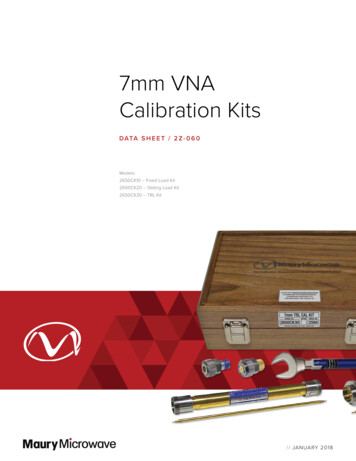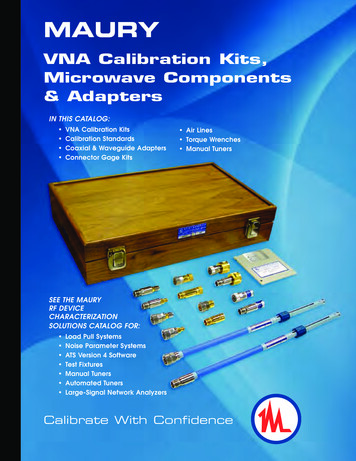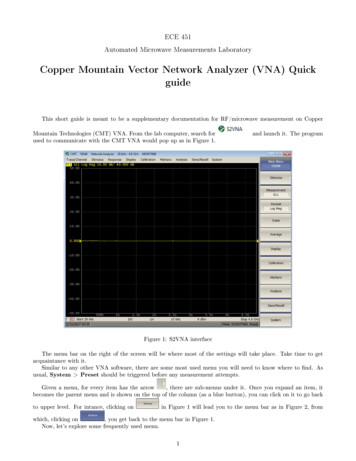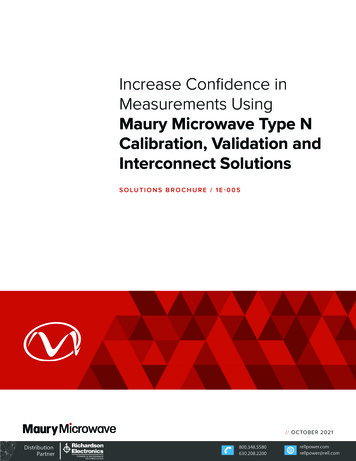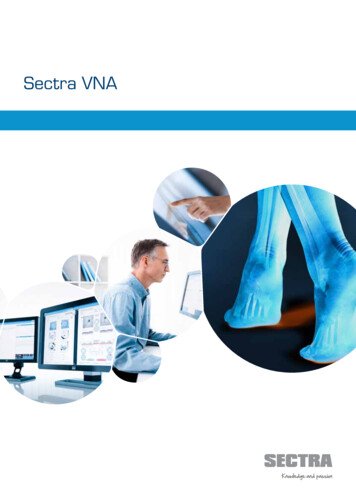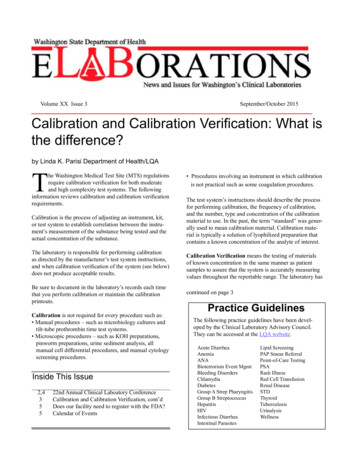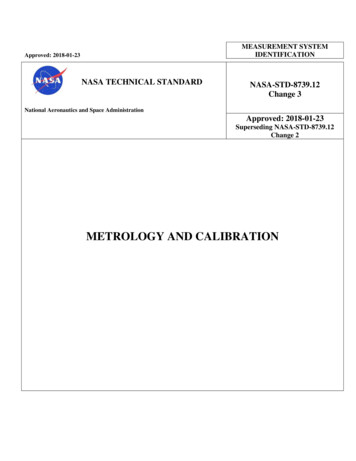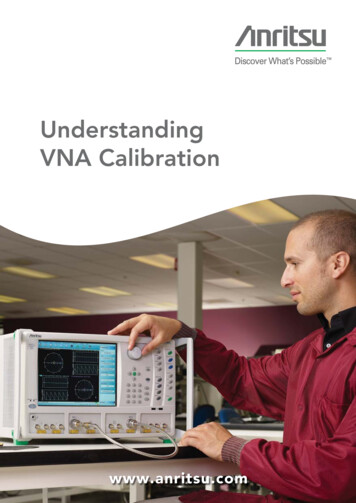
Transcription
UnderstandingVNA Calibrationwww.anritsu.com
Table of ContentsCalibration Overview . 2Calibration Summary . 2Calibration Algorithms . 3Configuring the VNA . 4Frequency Start, Stop and Number of Points . 4IF Bandwidth and Averaging . 4Point-by-point versus sweep-by-sweep Averaging . 4Power . 4Types of Calibration . 5Full 2-port . 5Full 1-port . 51-path 2-port (forward or reverse) . 5Frequency Response (reflection response and transmission-frequency response) . 5Line Types . 7Calibration Kits . 9SOLT Kits . 9Kits with Triple-Offset Shorts . 10LRL Kits . 10Microstrip & Coplanar Waveguide Kits for the Universal Test Fixture . 11On Wafer Calibration Kits . 11Automatic Calibration (AutoCal) . 12Precision AutoCal Calibration Module . 12Physical Setup . 14Other AutoCal Topics . 14Thru Type . 14AutoCal Assurance . 14Test Port Converters . 14Chartacterization . 15Nojn-insertable Measurements . 15SOLT . 16Calibration Model Accuracy . 16Triple Offset Short . 19Offset Short . 19SOLR (Unknown Thru Approach) . 21LRL/LRM/ALRM . 23Isolation . 28Adapter Removal . 29Thru Update . 31Interpolation . 31Calibration Merge . 32Network Extraction . 32Summary . 341 Understanding VNA calibration
In this guide, the concept of calibration is presented and discussed in detail. Specific topicsto be covered include how to configure the VNA for calibration, types of calibration andcalibration kits. A minimal amount of calibration mathematics and theory will also be covered.Calibration OverviewCalibration is critical to making good VNA S-parameter measurements. While the VNA is ahighly-linear receiver and has sufficient spectral purity in its sources to make goodmeasurements, there are a number of imperfections that limit measurements done withoutcalibrations. These imperfections include:1. Match—Because the VNA is such a broadband instrument, the raw match is decent butnot excellent. Even a 20-dB match, which is physically very good, can lead to errors ofgreater than 1 dB. Correcting for this raw match greatly reduces the potential error.2. Directivity—A key component of a VNA is a directional coupler. This device allows theinstrument to separate the signal incident on the DUT from the signal reflected back fromthe DUT. While the couplers used in the VNA are of very high quality, there is a certainamount of coupled signal, even when a perfect termination is connected. This is related todirectivity and can impact measurements of very small reflection coefficients.3. Frequency Response—While the internal frequency response of the VNA could becalibrated at the factory, any cables connected externally will have some frequencyresponse that must be calibrated out for high-quality measurements.Calibration SummaryCalibration is a tool for correcting for these imperfections, as well as other defects. There arean enormous number of possible calibration algorithms and many of them are implementedwithin VNAs. The choice between them is largely determined by the media the engineer isworking in, the calibration standards available and the desired accuracy/ effort trade off.While these choices will be discussed in detail later in this chapter, they can be categorizedaccording to two distinctions: calibration type (e.g., which ports are being corrected and towhat level they are being corrected) and calibration algorithm (e.g., how the correction isbeing accomplished). A summary of calibration types is provided in Table 1.w w w. a n r i t s u . c o m2
TypeParameters calibratedUsesFull 2-portS11, S12, S21, and S22Most complete calibrationFull 1-portS11 or S22 or S11 and S22Reflection only1-path 2-portS11 and S21 or S22 and S121-port reflection plus simple transmission(faster, lower transmission accuracyunless DUT very lossy)Frequency responseAny one parameter (or pairs ofsymmetric parameters)Normalization only. fast, lower accuracyTable 1 - This table summarizes the various types of calibration available to the VNA userCalibration AlgorithmsCalibration algorithms are a forest of acronyms. In literature these acronyms are often timesinconsistent. To add further confusion, the letters may represent different things at differenttimes. Table 3-2 shows the acronyms used in Anritsu documentation and is intended toprovide a representation of the most common usage of algorithm acronyms.Calibration AlgorithmDescriptionAdvantagesDisadvantagesSOLT (short-open-load-thru)Common coaxiallySimple, redundantstandards; not band limitedRequires very well-defined standards,poor on-wafer, lower accuracy at highfrequencySSLT (short-short-load-thru),shorts with different offsetlengthsCommon in waveguideSame as SOLTSame as SOLT and band-limitedSSST (Short-short-shortthru), all shorts with differentoffset lengthsCommon in waveguide orhigh frequency coaxSame as SOLT butbetter accuracy athigh frequencyRequires very well-defined standards,poor on-wafer, band-limitedSOLR/SSLR/SSSR, like abovebut with ‘reciprocal’ insteadof ‘thru’Like the above but whena good thru is not availableDoes not requirewell-defined thruSome accuracy degradation, butslightly less definition, otherdisadvantages of parent calibrationLRL (Line-reflect-line),also called TRLHigh performance coax,waveguideor on-waferHighest accuracy,minimal standarddefinitionRequires very good transmission lines,less redundancy so more care isrequired, band-limitedALRM* (advanced linereflect-match), also calledTRMRelatively high performanceHigh accuracy, onlyone line length soeasier to fixture/onwafer, not band-limitedusuallyRequires load definition. Reflectstandard setup may requirecare depending on load model usedTable 2 - This table summarizes the different calibration algorithmsavailable to the VNA user.*ALRM is an Anritsu enhancement to standard LRM that includes advanced load-modeling techniques and structures. In itsbasal form of a default-load model, it is conventional LRM. The terms LRM and ALRM are used somewhat interchangeably,except in cases where the load modeling context is important.3 Understanding VNA calibration
Configuring The VNABefore discussing calibration further, and some of the alternatives available, it is important tofirst gain a clear understanding of any VNA setup issues as they will affect calibrationperformance. In almost all cases, the VNA settings are used during calibration. Therefore,setting up the VNA as desired beforehand can be especially helpful. The settings of interestare:1. Frequency Start, Stop and Number of Points - These settings are obvious. Segmentedsweep must also be setup in advance if a more custom frequency list is desired.2. IF Bandwidth and Averaging These parameters control the digitalfiltering and post processing thatdetermine the effective noise floor,amount of trace noise and, in somespecial cases, immunity to interferingsignals. The trade off for improvednoise performance is slower sweepspeed.Figure 3-1 provides an example oftwo IF-bandwidth settings. Settingsof 1 Hz to 1 MHz are allowed withthe root-mean-square (RMS) trace Figure 1. Shown here is the noise floor from a1 kHz and 10 Hz IF bandwidth setting.noise ranging from less than 1 mdBat the low end, to a few hundred mdB at the high end for high level signals. The valueswill be larger for lower level signals. Sweep time is roughly proportional with the reciprocalof IF bandwidth (IFBW) once below 100-kHz IFBW.3. Point-by-Point versus Sweep-by-Sweep Averaging - Point-by-point averaging incursadditional measurements at each given frequency point and increases sweep timeroughly proportionally. Because the additional measurements are taken at once, theeffect is similar to the proportional change in IFBW. An additional benefit is that thedisplayed data is fully optimized during the first sweep.Sweep-by-sweep averaging acquires additional measurements on subsequent sweeps.The result is a gradual shift in trace amplitude. Before extracting data, the VNA user mustverify that a fully corrected sweep has occurred. Sweep-by-sweep averaging is a rollingw w w. a n r i t s u . c o m4
average, so the time it takes to fully stabilize from a sudden DUT change is roughlyproportional to the average count. Consequently, it offers an alternate way to improvelower-frequency variations.4. Power - Port power in the MS4640A VectorStar VNA is somewhat less critical due to theexcellent linearity of the receivers, but any step-attenuator settings must be selectedbefore calibration. Changing the step-attenuator settings alters the RF match in themeasurement paths as well as in the insertion loss thus. Therefore, changing them willinvalidate the calibration.An important aspect of test-set power level is the consideration of dynamic range. Settingthe port power to the maximum level before receiver compression provides the widestpossible signal-to-noise floor ratio and thus dynamic range. Be sure to perform this settingbefore beginning calibration.Types of CalibrationsThere are several types of calibrations, defined by what ports are involved and what level ofcorrection is accomplished. These calibration types include: Full 2-Port - This is the most commonly used and most complete calibration involving twoports. All four S-parameters (S11, S12, S21, and S22) are fully corrected. Full 1-Port - In this case, a single reflection parameter is fully corrected (either S11 or S22).Both ports can be covered but only reflection measurements will be corrected. Thiscalibration type is useful for reflection-only measurements, including the possibility ofdoing two reflection-only measurements at the same time. 1-Path 2-Port (forward or reverse) - In this case, reflection measurements on one portare corrected and one transmission path is partially corrected, but load match is not. Hereforward means that S11 and S21 are covered, while reverse means that S12 and S22 arecovered. This technique may be used when speed is at a premium, only 2 S-parametersare needed and either the accuracy requirements on the transmission parameter are lowor the DUT is very lossy (approximately greater than 10 to 20 dB insertion loss). Frequency Response (reflection response and transmission-frequency response) - Thiscalibration is essentially a normalization and partially corrects one parameter, althoughtwo can be covered within the calibration menus. Only the frequency response, ortracking slope, of the parameter is corrected. Directivity and match behaviors are nottaken into account. This technique is valuable when accuracy requirements are not at apremium and all that is needed is a quick measurement.5 Understanding VNA calibration
Each of these calibrations has an associated error model that describes what is beingcorrected. These error models are briefly covered in this chapter. For more detailedinformation, refer to Anritsu’s available application notes on the subject matter.The error coefficients used in the error models fall into several categories that roughlydescribe the physical effect that the coefficients are responsible for correcting. To establish acontext for these error terms, consider a typical model in which all of the VNA/setup errorsare lumped into error boxes that act like S-parameters, between a perfect VNA and the DUTreference planes (Figure 2). Two slightly different error models are used: one where each portis considered to be driving separately and one where both ports are present and no drivingdistinction is made. In the first error model, one can clearly delineate the source match fromthe load match. The second model requires some preprocessing to take care of sourcematch-load match differences.Figure 2 - Classical 1-port and 2-port error models are shown here1.w w w. a n r i t s u . c o m6
Using Figure 2 as a reference, the error terms can be defined as follows:1. Directivity (ed1 and ed2) - Describes the finite directivity of the bridges or directionalcouplers in the system. Partially includes some internal mismatch mechanisms thatcontribute to effective directivity.2. Source Match (ep1S and ep2S) - Describes the return loss of a driving port.3. Load Match (ep1L and ep2L) - Describes the return loss of a terminating port. In the 8term error models used as a basis for the LRL/ALRM and other calibration families, loadmatch is treated the same as source match, but the incoming data is pre-corrected to takeinto account the measured difference in match between driving and terminating states.4. Reflection Tracking (et11 and et22) - Describes the frequency response of a reflectmeasurement, including loss behaviors due to the couplers, transmission lines, converters,and other components.5. Transmission Tracking (et12 and et21) - Same as above, but for the transmission paths.The tracking terms are not entirely independent and this fact is used in some of thecalibration algorithms.6. Isolation (ex12 and ex21) - This term takes into account certain types of internal (e.g., nonDUT dependent) leakages that may be present in hardware. It is largely present for legacyreasons and is rarely used in practice since this type of leakage is typically very small inmodern VNAs. These terms are handled somewhat differently from the others and will becovered later in this guide.Line TypesPart of the calibration definition is the selection of line type or transmission media. The mainpurpose of this selection process is to assign a dispersion characteristic. Dispersion is thedependence of the phase velocity on the line with frequency. Media such as coax andcoplanar waveguides are largely dispersion-free; that is, phase velocity can be defined by asingle number:сνph 7phase velocity for coaxial an non-dispersive media εr Understanding VNA calibration
Here c is the speed of light in a vacuum ( 2.9978 108 m/s) and εr is the relative permittivity ofthe medium involved. Coax has its own selection since it is intrinsic to the instrument, whileother non-dispersive media can be selected separately.One type of dispersive media is the regular waveguide. The phase velocity here is definedby:сνph εr( (ƒc1- ƒ с 2εr -( (ƒc 02phase velocity for waveguideƒHere εr is the dielectric constant, ƒc is the cutoff frequency of the waveguide (with dielectric)and ƒc0 is the cutoff frequency of the waveguide in a vacuum (which is what is entered). Thesystem computes the required values and this information is used for computing distanceswhen in time domain and when adjusting reference planes.Microstrip lines are another example of dispersive media that can be selected. Here thedimensions of the line, together with the dielectric material, determine the phase-velocitybehavior. An intermediate quantity, called the effective dielectric constant (εr,eƒƒ), is used anda suggested value computed by the VNA, but this value can be overridden. At lowfrequencies, the structure can be considered non-dispersive (like coax) with a phase velocitygiven by:сνph εr , eƒƒlow frequency limitAt higher frequencies, when additional mode behavior becomes important, dispersion mustbe handled. The dielectric constants (media-based and effective), together with a transitionfrequency ƒt, are used to compute this effect which is heavily dependent on the dielectricthickness.w w w. a n r i t s u . c o m8
сνph ( (( (εr,eƒƒ εr 1 ƒƒ2ƒt2ƒtWhereƒt Zсε0 εrc22t εr , eƒƒHere Zc is the characteristic impedance of the microstrip line and t is the dielectric thicknessCalibration KitsAnritsu and other vendors provide calibration kits for a variety of algorithms andcircumstances. In all cases, certain information must be provided to the VNA in order tocomplete the calibration. The nature of that information varies by kit and application. As anexample, consider the following coaxial calibration kits available from Anritsu. SOLT KitsThese kits are all based on SOLT and require that data describing all of the reflectionstandards (provided by the factory) be loaded into the VNA on a serial number basis. If thismedia (e.g., USB key or floppy disk) is not available, average default coefficients are availablewithin the VNA and may suffice for some measurements.Typically these calibration kits are loaded using the Cal Kit/AutoCal utility menu, but userdefined kits can also be created using the parameters described above. If calibration kits fromanother manufacturer are used, or if the engineer wants to create a calibration kit, theparameters are typically entered into one of the user-defined kits.Items required as part of the definition are: Open definition (M and F, typically)9 Understanding VNA calibration
Short definition (M and F, typically) Load definition (M and F, typically) Kits With Triple-Offset ShortsSome kits employ multiple algorithms to cover larger frequency ranges. The Anritsu 36 6110 GHz Calibration Kit uses a triple-offset short scheme for frequencies up to 110 GHz,where it is more difficult to characterize opens and loads. At lower frequencies, an SOLTcalibration is used in a banded approach, since the SSST is fundamentally band-limited. Oftena merge calibration method is used to combine the triple-offset short and SOLT calibrations.Some additional standards definitions are therefore required, but the general procedure isthe same as for an SOLT kit. User-defined kits can be generated for custom kits or for thosefrom another manufacturer.Items required as part of the definition are: Open definition (for low frequency, M and F)Load definition (for low frequency, M and F)Short 1 definition (M and F)Short 2 definition (M and F)Short 3 definition (M and F) LRL KitsThese airline-based kits use the LRL algorithm so much less definition of components isrequired. Reflects may be part of the kit, but the only piece of information necessary is anoffset length which is used to help with root selection and is hence somewhat non-critical.Line lengths are the other parameters and are mainly used for reference plane placement. Allof these parameters must be entered manually since there are a large number of lines in thekit and usually only 2 or 3 will be used per calibration. Details on line selection and the tradeoffs involved are discussed in the LRL/LRM section later in this chapter.Items required as part of the definition are: Line lengths (at least 2) Reflect offset length Offset-Short Waveguide KitsWaveguide calibration kits based on offset-short calibrations are also provided for differentwaveguide bands. Here two different offset-length shorts (sometimes accomplished withflush shorts and two different insert lengths), loads and a thru must be specified. Some of thew w w. a n r i t s u . c o m10
standard kits are pre-defined and user-defined kits are possible as usual. Additional pieces ofinformation needed here due to line type are the cutoff frequency and dielectric constant.Items required as part of the definition are: Load definitionShort 1 definitionShort 2 definitionWaveguide cutoff frequency Microstrip and Coplanar Waveguide Kits for the Universal Test FixtureFor certain microstrip and coplanar waveguide measurements, the Universal Test Fixture(Anritsu model 3680 Series) can be used as it accommodates a range of substrate sizes andthicknesses. The supplied calibration kits provide opens, shorts, loads, and a variety oftransmission-line lengths on alumina that can be used for different calibration algorithms.User-defined kits must be generated based on the information provided with the kits. On-Wafer Calibration KitsA variety of calibration-standard substrates or impedance-standard substrates are availablefrom other vendors that contain opens, shorts, loads, and transmission lines for on-wafercalibrations. A variety of calibration algorithms may be used depending on the application.For the defined-standards calibrations, a user-defined kit will have to be generated.11 Understanding VNA calibration
Automatic Calibration (AutoCal)In contrast to the mechanical standards approach to calibration, automatic calibrationmodules can be used to simplify the calibration method. Automatic calibration techniques,such as those performed by the AutoCal modules available from Anritsu, are often thepreferred method for calibrating VNAs. AutoCal provides VNA users with the ability toquickly calibrate the network analyzer with the simple push of a button. The AutoCal moduleincorporates extremely accurate, repeatable solid-state switches to select a variety ofimpedance standards from just one connection between the VNA and a calibrator module.Precision AutoCal Calibration ModuleCalibrations employing AutoCal modules are consistent, repeatable and provide betteraccuracy than traditional broadband-termination, 12-term calibrations. In addition, automaticcalibrations are much faster than with traditional calibration kits. For example, a 401-point,12-term AutoCal takes typically 30 seconds when using the VectorStar VNA, as compared tothe 10 to 1 minutes it takes with a traditional calibration kit. In addition, calibrating with thePrecision AutoCal module requires only two connections, while a mechanical calibration kitrequires 7 to 9 connections for a typical calibration. Note that test-port characteristicspecifications require a sliding load-termination calibration, thereby further escalating thecomplexity of the calibration. Sliding-load terminations require a high level of expertise andcare due to their mechanical complexity. If broadband terminations are used, the resultantdirectivity and port-match performance will suffer.A further benefit of the Precision AutoCal process stems from the flexibility of the PrecisionAutoCal characterization process which allows users to measure: Non-insertable devices. Devices with different connector types on each port. Devices with waveguide or coaxial connectors, as well as several other combinations.The automatic calibrator module also saves wear and tear on traditional calibrationcomponents and eliminates operator mistakes, such as incorrect use of calibrationcoefficients. In addition, it still maintains the accuracy required for critical measurements.The basic concept in Precision AutoCal is the transfer of known calibration parameters froma traceable VNA to measure the calibration standards within the Precision AutoCal module—a process referred to as Precision AutoCal characterization. A calibrated VNA (using atraceable calibration kit) measures the S-parameter data of each impedance standardthroughout the calibrator module’s frequency range. The accuracy of the calibrated VNA isw w w. a n r i t s u . c o m12
thereby transferred to the Precision AutoCal module. The stability and repeatability of thePrecision AutoCal impedance standards provides excellent automatic calibrations over adefined time frame. This method of impedance transfer typically results in limited sacrifice ofaccuracy for simplicity, speed and convenience. But, by combining the Precision AutoCalcalibrator with the MS4640A VectorStar VNA, the resulting overall measurement accuracy isbetter than a mechanical standards calibration, including sliding-load terminations. Thisaccomplishment is reached through the use of ultra-precision LRL/LRM calibration and overdetermined algorithms.The following discussion includes both types of AutoCal modules. In the areas that are uniqueto the newer AutoCal technology, the term Precision AutoCal will be used.The AutoCal calibration process represents both a calibration device and an algorithm thatcan be used to speed up the calibration process with extremely high accuracy and a minimalnumber of manual connections. Anritsu offers two types of AutoCal modules; the 36 8 XSeries Precision AutoCal and the 36 81X Series Standard AutoCal. Both AutoCal seriescalibrate the VNA by a process known as ‘transfer calibration.’ There are a number ofimpedance and transmission states in the module designed to be extremely stable in timeand these states are carefully ‘characterized,’ generally by the Anritsu factory. In certain cases,this characterization can also take place in a customer laboratory. When the same states arere-measured during an actual calibration and the results compared to the characterizationdata, an accurate picture is generated of the behaviors and error terms of the VNA and setupbeing calibrated.Very high calibration accuracy is maintained through the use of certain principles: The use of many impedance and transmission states covering as wide a range as possibleacross the Smith chart. The creation of very stable states that are further enhanced with a constant-temperaturethermal platform inside the module. The use of very reliable and repeatable solid-state switching constructed to provide a greatvariety of state impedances for better calibration stability.The resulting accuracy can exceed the performance obtained using a common SOLTmechanical calibration with sliding loads—a proc
www.anritsu.com 4 Configuring The VNA Before discussing calibration further, and some of the alternatives available, it is important to first gain a clear understanding of any VNA setup issues as they will affect calibration
